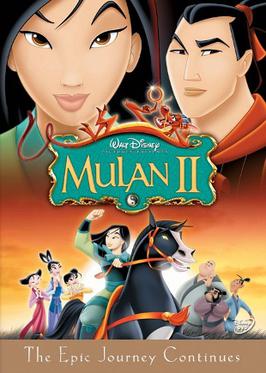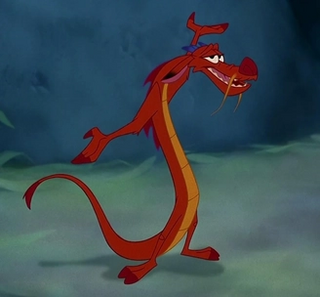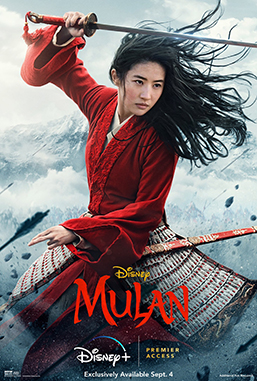Fa Mulan is a fictional character, inspired by a legendary figure, who appears in Walt Disney Pictures' animated film Mulan (1998). Her speaking voice is provided by actress Ming-Na Wen, while singer Lea Salonga provides the character's singing voice. Created by author Robert D. San Souci, Mulan is based on the legendary Chinese warrior Hua Mulan from the poem the Ballad of Mulan. Her name "Fa Mulan" is inspired by the Yue Chinese name for the character, which is pronounced Fa Muklan. The only child of an aging war veteran, Mulan disregards both tradition and the law by disguising herself as a man in order to enlist herself in the army in lieu of her feeble father.

Lilo & Stitch is a 2002 American animated science fiction comedy drama film produced by Walt Disney Feature Animation and released by Walt Disney Pictures. It was written and directed by Chris Sanders and Dean DeBlois and produced by Clark Spencer, based on an original story created by Sanders. It stars Daveigh Chase and Sanders as the voices of the title characters, with the voices of Tia Carrere, David Ogden Stiers, Kevin McDonald, Ving Rhames, Jason Scott Lee, Zoe Caldwell, and Kevin Michael Richardson in supporting roles. It was the second of three Disney animated feature films produced primarily at the Florida animation studio in Disney-MGM Studios at Walt Disney World near Orlando, Florida.

Ming-Na Wen is an American actress and model. Wen is known for her work in both film and television, as well as her work as a voice actress.

Mulan II is a 2004 American animated direct-to-video musical adventure film produced by Walt Disney Pictures and DisneyToon Studios and distributed by Buena Vista Home Entertainment. The film was directed by Darrell Rooney and Lynne Southerland and produced by Jennifer Blohm, from a screenplay written by Michael Lucker, Chris Parker, and Roger S. H. Schulman.
"I'll Make a Man Out of You" is a song written by composer Matthew Wilder and lyricist David Zippel for Walt Disney Pictures' animated film Mulan (1998). Appearing on the film's soundtrack Mulan: An Original Walt Disney Records Soundtrack, "I'll Make a Man Out of You" is performed by American singer Donny Osmond as the singing voice of Captain Li Shang in lieu of American actor BD Wong, who provides the character's speaking voice. The song also features contributions from Lea Salonga as the singing voice of Mulan, Eddie Murphy as Mushu, and Harvey Fierstein, Jerry Tondo and Wilder himself as Yao, Chien-Po and Ling, respectively. In addition, Mushu has a speaking line unlike the other characters in the song.

Mushu is a fictional character in Disney's Mulan franchise, first appearing in the 1998 animated film Mulan. A small Chinese dragon, Mushu was a spiritual guardian of Mulan's family before he was demoted for failing to protect an ancestor. He plots to redeem himself by ensuring Mulan's safety and success when she enlists herself in the army in her father's place, ultimately becoming her closest confidant. In the sequel Mulan II, he attempts to sabotage Mulan's impending marriage in order to remain her guardian.

The Magic of Disney Animation was a show and tour located at Disney's Hollywood Studios at Walt Disney World in Orlando, Florida. A Disney animator would show guests how the characters in Disney animated films were chosen and designed. The attraction closed permanently on July 12, 2015. In December 2015, the building began to be used to house the Star Wars Launch Bay.

The Disney Renaissance was a period from 1989 to 1999 during which Walt Disney Feature Animation returned to producing commercially and/or critically successful animated films. The ten feature films associated with this period are The Little Mermaid (1989), The Rescuers Down Under (1990), Beauty and the Beast (1991), Aladdin (1992), The Lion King (1994), Pocahontas (1995), The Hunchback of Notre Dame (1996), Hercules (1997), Mulan (1998), and Tarzan (1999).

Mark Alan Henn is an American animator and film director. His work includes animated characters for Walt Disney Animation Studios films, most notably leading or titular characters and heroines. He served as the lead animator for Ariel in The Little Mermaid (1989), Belle in Beauty and the Beast (1991), Jasmine in Aladdin (1992), Young Simba in The Lion King (1994), the title character in Mulan (1998), and Tiana in The Princess and the Frog (2009). Since all these characters except Simba became Disney Princesses, he came to be known as the "princess guy" around the studio. He directed the short films John Henry (2000) and D.I.Y. Duck (2024). Henn spent a total of 43 years at Walt Disney Animation Studios, from 1980 until his retirement in 2023.
Art of Disney Animation is an attraction at the Disney California Adventure in Disneyland Resort and Hong Kong Disneyland in Hong Kong Disneyland Resort. In Walt Disney Studios Park, the attraction opened on March 16, 2002 in the Toon Studio area, but was closed on January 7, 2019. It was reopened on November 17, 2019.
Mulan Jr. is a one-act stage musical based on the 1998 Disney animated film Mulan, which in turn was based on the Chinese legend of Hua Mulan and the story "Fa Mulan" by Robert D. San Souci. The adaptation mixes songs featured in the 1998 film as well as deleted songs from the film, including the revival of songs written by Stephen Schwartz, who was the original composer for the 1998 film before leaving to work on The Prince of Egypt. The musical is G-rated, any mature content from the sources it is based on having been deleted in the adaptation. The cast includes 26 roles plus an ensemble. The show was taken down from MTI's website in the summer of 2020, but it's being considered as a re-release but no date is currently set for if that does happen.
1998 in animation is an overview of notable events, including notable awards, list of films released, television show debuts and endings, and notable deaths.
Barry Cook is an American film director who has worked in the animated film industry since the 1980s. Cook and Tony Bancroft directed Mulan (1998), for which they won the 1998 Annie Award for Best Animated Feature. Cook was also the co-director for Arthur Christmas (2011), directed by Sarah Smith. Cook also directed Walking with Dinosaurs (2013) with Neil Nightingale.

Zootopia is a 2016 American animated buddy cop comedy film produced by Walt Disney Animation Studios. It was directed by Byron Howard and Rich Moore from a screenplay by Jared Bush and Phil Johnston. The film stars the voices of Ginnifer Goodwin, Jason Bateman, Idris Elba, Jenny Slate, Nate Torrence, Bonnie Hunt, Don Lake, Tommy Chong, J. K. Simmons, Octavia Spencer, Alan Tudyk, and Shakira. The film follows a rookie police officer rabbit and a con artist fox as they work together to uncover a conspiracy involving the disappearance of predators.
"Honor to Us All" is a song written by composer Matthew Wilder and lyricist David Zippel for Walt Disney Pictures' animated film Mulan (1998). Recorded by singers Beth Fowler, Marni Nixon and Lea Salonga, the latter two of whom provide the singing voices of Grandmother Fa and Fa Mulan, respectively, the song is a character number performed by several older Chinese women and female members of Mulan's family as they prepare the main character to be evaluated by the Matchmaker in the scene towards the beginning of the film.

Mulan is an American Disney media franchise that began in 1998 with the theatrical release of Mulan.

Mulan is a 2020 American fantasy action drama film produced by Walt Disney Pictures. Directed by Niki Caro from a screenplay by Rick Jaffa, Amanda Silver, Lauren Hynek, and Elizabeth Martin, it is a live-action adaptation of Disney's 1998 animated film Mulan, itself based on the Chinese folklore story Ballad of Mulan. The film stars Yifei Liu in the title role, alongside Donnie Yen, Tzi Ma, Jason Scott Lee, Yoson An, Ron Yuan, Gong Li, and Jet Li in supporting roles. In the film, Hua Mulan, the eldest daughter of an honored warrior, masquerades as a man to take her ailing father's place during a general conscription to counter the Rouran army in Imperial China.
This article features the history of the representation of lesbian, gay, bisexual, transgender and queer (LGBTQ) characters in animated productions under The Walt Disney Company, including films from the studios Walt Disney Animation Studios and Pixar, and programming from the Disney Branded Television channels as well as the streaming service Disney+. From 1983 onward, Disney struggled with LGBTQ representation in their animated series, and their content often included LGBTQ stereotypes or the content was censored in series which aired on Toon Disney such as Blazing Dragons. Some creators have also criticized Disney studio executives of cutting LGBTQ scenes from their shows in the past, or criticized that their shows were not seen as part of the "Disney brand", like The Owl House.
















